NavSource Online: Submarine Photo Archive
To Additional Pages
| Click On Image For Full Size | Size | Image Description | Source | |
|---|---|---|---|---|
 | 946k | I-400 (Cdr Utsunosuke Kusaka) leaving Ominata Naval Base accompanied by I-401, I-13 and I-14 for her final aborted mission to bomb the Panama Canal Locks - an operation cancelled in favour of attacking the U.S. Fleet at Ulithi Atoll on the Japanese principle that 'a man does not worry about a fire he sees on the horizon when other flames are licking at his Kimono sleeve'. | Imperial Japanese Navy photo. Image and text from "Submarine Warfare: Monsters and Midgets" by Richard Compton Hall, Blandford Press, Poole, Dorset, England & Utsunosuke Kusaka inset photo image and text from Storm From A Clear Sky by John J. Geoghegan. Photo courtesy of Robert Hurst. |
|
 | 126k | This is the only known photograph of a Sen-toku sub taken by the Japanese during World War II. It shows two Aichi M6A1 attack planes on deck waiting to be launched. Nicknamed Seiran, the aircraft were intended to appear over New York City and Washington, DC just as their name suggested: "like a storm from a clear sky." Only two classes of subs were purpose built to carry Seiran: the I-400 class, and the Type A modified subs (I-13 and I-14), which were based on the I-9. The I-400s carried three planes each while the I-13 and I-14 could only fit two in part because they were 28 feet shorter than the I-400s total length of 401 feet. | Imperial Japanese Navy photo. Image and text from Storm From A Clear Sky by John J. Geoghegan. |
|
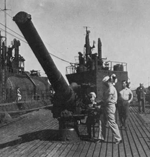 | 516k | Five photo PDF of the I-400, circa 1945-46. | Photo courtesy of Robert Hurst. | |
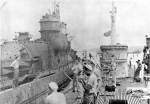 | 178k | Blower (SS-325) in Tokyo Bay next to captured Japanese submarine I-400, circa September 1945. | USN photo courtesy of usssubvetsofwwii.org. | |
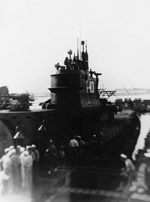 | 225k | I-401 in Tokyo Bay, September 1945. Submarine Squadron One, which consisted of I-13, I-14, I-400 & I-401 was commanded by a sadistic s.o.b. by the name of Tetsunosuke Ariizumi, who was responsible for the cold blood murder of Allied seaman whose ships he sank while commanding the I-8 in 1944. |
USN photo courtesy of Scott Koen & ussnewyork.com. | |
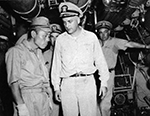 | 322k | Commander Toshio Kusako, Commanding Officer of surrendered Japanese submarine I-14 in Sagami Bay, Japan, possibly 29 August 1945. He is being questioned by U.S. Navy officer. | USN photo # 80-G-349383, courtesy of the Library of Congress, from the National Museum of the U.S. Navy, courtesy of flickr.com. | |
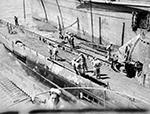 | 321k | Shown are Japanese submarines I-14, (foreground), and I-401, moored alongside Proteus (AS-19), in Sagami Bay, Japan, possibly 29 August 1945. | USN photo # 80-G-349384, courtesy of the Library of Congress, from the National Museum of the U.S. Navy, courtesy of flickr.com. | |
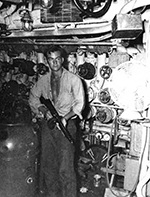 | 321k | F1/C William Gibson stands guard with tommy gun in control room of surrendered Japanese submarine I-14 after prize crew brought vessel into Sagami Bay, Japan, possibly 29 August 1945. | USN photo # 80-G-349381, courtesy of the Library of Congress, from the National Museum of the U.S. Navy, courtesy of flickr.com. | |
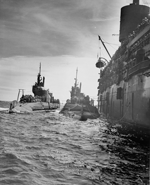 0849621 |
3.52k | Flying black flags of surrender, two Japanese submarines which bowed to American forces 200 miles off the Japanese mainland rest at anchor alongside a giant transport. This photo showing the sterns of the underseas raiders was made by a Coast Guard combat photographer aboard a Coast Guard-manned LST which was among the first cargo-bearing vessels to reach Japan. Photo taken from LST-789 on 30 August 1945. | National Archives Identifier: 205585303 Local Identifier: 26-G-4782 Photo courtesy of catalog.archives.gov via David Upton via Gary Priolo. |
|
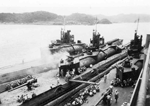 | 205k | Outboard to inboard: I-14, I-401 & I-400 in Tokyo Bay, circa September 1945. You can see Japaneses sailors sitting around on the decks. Remember the time frame we are dealing with here: this is just days after the surrender and the sailors would have been kept to be interviewed regarding the operation of the subs. In fact, in several of the photos you can see individual and groups of Japanese talking with US sailors. |
Photo & text from the private collection of Ric Hedman. Text i.d. courtesy of John Hart. | |
 | 291k | I-402 bridge. | USN photo courtesy of Scott Koen & ussnewyork.com. | |
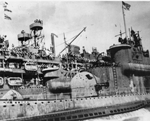 | 375k | Outboard to inboard: I-400 & I-401 alongside Proteus (AS-19) in Tokyo Bay, September 1945. | USN photo courtesy of Scott Koen & ussnewyork.com. | |
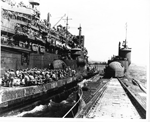 | 289k | I-14 & I-400 alongside Proteus (AS-19) in Tokyo Bay, September 1945. | Photo courtesy of John Hummel, (USN) retired. | |
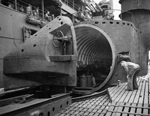 | 480k | Hangar tube on board giant Japanese submarine, I-401, which housed three "Jake" type airplanes. Photograph released 20 September 1945. | USN photo # 80-G-495645, courtesy of the Library of Congress, from the National Museum of the U.S. Navy, courtesy of flickr.com. | |
 | 138k | I-400 & I-14 in Tokyo Bay, September 1945. | USN photo courtesy of Scott Koen & ussnewyork.com. | |
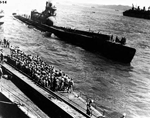 | 204k | American sailors line up to view the I-400 in Tokyo Bay, September 1945. | USN photo courtesy of Scott Koen & ussnewyork.com. | |
 | 44k | I-401 in Tokyo Bay, September 1945. | USN photo courtesy of Scott Koen & ussnewyork.com. | |
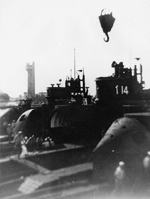 | 203k | I-14 with hangar open & I-400 at Pearl Harbor, September 1945. | Photo i.d. courtesy of Ric Hedman. USN photo courtesy of Scott Koen & ussnewyork.com. |
|
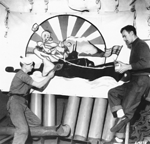 | 946k | I-400 Prize crew logo. | USN photo from Storm From A Clear Sky by John J. Geoghegan via Ron Reeves (of blessed memory). | |
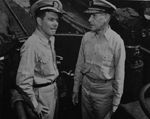 | 266k | On board the captured Japanese submarine, I-401, at Yokosuka, Japan, Admiral Raymond A. Spruance looks over this latest command of his son, Commander Edward Spruance, 1 October 1945. | USN photo # 80-G-495765, courtesy of the Library of Congress, from the National Museum of the U.S. Navy, courtesy of flickr.com. | |
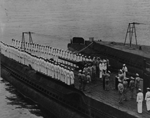 | 415k | Officers and men of the US Navy witness the presentation of awards to members of the US Navy's Submarine Force by Admiral Raymond A. Spruance, Commander Fifth Fleet on the fantail of the ex-Japanese submarine, I-401, at Yokosuka, Japan. | USN photo # 80-G-495764, courtesy of the Library of Congress, from the National Museum of the U.S. Navy, courtesy of flickr.com. | |
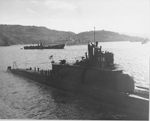 | 610k | I-14 as seen from the Euryale (AS-22), 5 November 1945. In the background is a hospital ship and a landing craft. |
US National Archives photo # 80g 264364, from NARA, College Park, Maryland, courtesy of Sean Hert. | |
 | 876k | I-14 as seen from the Euryale (AS-22), 5 November 1945. In the background is a hospital ship and a landing craft. |
US National Archives photo # 80g 264365, from NARA, College Park, Maryland, courtesy of Sean Hert. | |
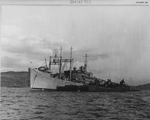 | 769k | The I's have it. From the Euryale (AS-22) outboard: I-401, I-14 & I-400 on 16 November 1945. |
US National Archives photo # 80g 264343 from NARA, College Park, Maryland, courtesy of Sean Hert. | |
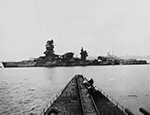 | 1.30k | Ships to be used for atomic bomb tests at Operations Crossroads, Bikini Atoll, Marshall Islands, 14 January 1946. Shown: Japanese battleship Nagato, port broadside. Note the sailors on the deck of the Japanese submarine. | Photo i.d. courtesy of John Hummel, USN (Retired). USN photograph # 80-G-701811, now in the collections of the National Archives courtesy of the National Museum of the U.S. Navy, via flickr.com. |
|
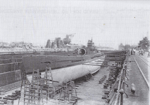 | 343k | I-400 in Dry dock # 1 Pearl Harbor 1946. | Photo courtesy of John Hummel, (USN) retired. | |
 | 417k | A combined shakedown and goodwill cruise to Caribbean ports in the early spring of 1946 preceded the Trumpetfish's (SS-425) westward cruise to Pearl Harbor. Highlighting the ship's training operations in Hawaiian waters was her intentional torpedoing of the large Japanese submarine I-400 which had been captured at the end of World War II.
Image 1 shows First torpedo hits just forward of conning tower and detonates the second torpedo before it hits the I-400. Image 2 shows I-400 from the port side after the first torpedo hit. Image 3 shows I-400 from port side after second torpedo hit on bow. Image 4 shows I-400 from starboard side as it slowly settles by the bow showing conning tower, hangar and upper decks still intact. |
Text courtesy of DANFS. Images from combinedfleet.com |
|
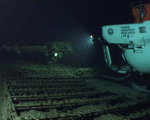 | 939k | The remains of two high-tech World War II Japanese submarines designed to attack the United States mainland have been found off Oahu. The announcement was made this morning by the National Oceanic and Atmospheric Administration's Undersea Research Lab at the University of Hawaii-Manoa and the National Geographic Channel. The submarines — the subjects of a National Geographic special, "Hunt for the Samurai Subs" — were part of a top-secret Imperial Japanese Navy plan to attack cities on the U.S. mainland, including New York and Washington, D.C. The I-14 was capable of carrying two fighter bombers while submerged; the I-201 was the fastest attack submarine of its time. Dr. Hans Van Tilburg, maritime heritage coordinator for NOAA's National Marine Sanctuaries in the Pacific Islands, said the submarines incorporated design and warfare concepts in use today. "If you look at a sub like the I-201 it was nothing like anybody had in World War II," he said. "It had a streamlined body and conning tower and retractable guns. It looks more like a Cold War sub. "And the (400-foot-long) I-14 predates the cruise missile concept." Similar to a modern-day "boomer," the I-14 carried enough fuel to travel around the globe, Van Tillburg said. That meant it could pop up off the East Coast, assemble and launch its folded-wing planes within 10 minutes and then submerge again. After the war, five of the subs were captured by the U.S. and brought back to Pearl Harbor where they were studied. They were intentionally sunk by the U.S. Navy in 1946 when Russian scientists began to demand access to the technology under terms of the treaty that ended the war. Since 1992, a team led by Hawaii Undersea Research Lab operations director Terry Kerby has used the manned submersibles Pisces IV and Pisces V to hunt for the Japanese subs. In March 2005, the team discovered the I-401 which could carry three aircraft. The I-14 and I-201 were found in February in 3,000 feet of water. Kerby said the search for the I-14 and I-201 was aided by veterans after the discovery of the I-401 became public. Joe Gould, who was assigned to be the executive officer of the I-14 while it was at Pearl Harbor, shot 16mm film of the sinking of the sub somewhere off Pearl Harbor. "As the (camera) panned from Kaena Point to Diamond Head, we were able to pick out landmarks and triangulate a rough position," Kerby said. Van Tilburg said Japan began working on the new fleet of submarines too late in the war and was only able to produce a small number of them. "If they had been able to produce them earlier, it might have turned the tide in some battles," he said. None of the submarines' missions were carried out. |
Photo & text from the honoluluadvertiser.com. | |
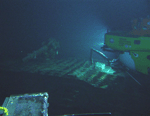 | 610k | I-400 off the coast of Oahu in approximately 2,300 feet of water. | Photo courtesy of news.yahoo.com via Fred Houpt. | |
Additional Resources and Web Sites of Interest
Hawaii Undersea Research Lab (HURL)
combinedfleet.com. Type AM
| Back To The Main Photo Index | Back To the Submarine Index |
| Problems and site related matters, E-mail Webmaster |
| This page is created by Michael Mohl ©1996 - 2022, NavSource History All rights reserved. |